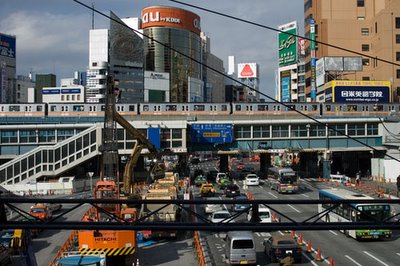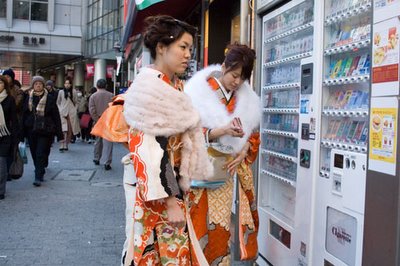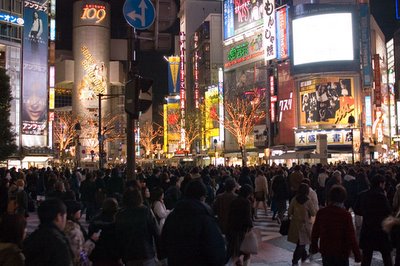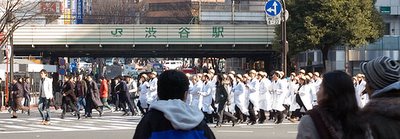
Driving back from the Obihiro Airport last night was an odd experience. It wasn't just the light snow falling. Where were the multitudes of people? The cars permanently parked in traffic? The constant noise? Buildings lit up like stars? I am back at the office today and bring you this description of Tokyo in two parts. Today I will introduce context about Tokyo I feel is important and detail Shibuya where I was staying. I am treating these posts as descriptions that will hopefully prove useful to anyone planning a trip to Tokyo. As I drove back, I was carrying around an unusual feeling that I had been away for ages. There is so much one can do while in Tokyo it seems to have a strange effect on how one perceives the passage of time.
Most of this post will be focused on Shibuya, a busy and populous district in Tokyo, one out of many with the same characteristics. It is the small differences, worth elaborating on, that draw me to Shibuya every time I come to Tokyo. My hotel was excellent, very well located off major roads, but still within walking distance to everything. (Very affordable too, but this is because I can now receive Japanese package discounts.)
 To understand Tokyo, in my opinion, one only need look at the public transportation system. It is in it's own class. There is a lot one could say about the system, but here I am force to focus only on the stations because of there societal and architectural significance. Any subway station in Tokyo inevitably creates an astounding amount of development and density around it. Stations such as Ginza, Roppongi, Shinjuku, Ikebukuro and on and on. This does not include what I would label mega-stations such as Tokyo Grand Central Station (over 180 entrance/exits) or Ueno, only because they have Shinkensen train lines added to numerous subway and train lines entering into the station. (A station like Shinjuku may be equally big but lacks Shinkansen lines.)
To understand Tokyo, in my opinion, one only need look at the public transportation system. It is in it's own class. There is a lot one could say about the system, but here I am force to focus only on the stations because of there societal and architectural significance. Any subway station in Tokyo inevitably creates an astounding amount of development and density around it. Stations such as Ginza, Roppongi, Shinjuku, Ikebukuro and on and on. This does not include what I would label mega-stations such as Tokyo Grand Central Station (over 180 entrance/exits) or Ueno, only because they have Shinkensen train lines added to numerous subway and train lines entering into the station. (A station like Shinjuku may be equally big but lacks Shinkansen lines.)Train stations in Tokyo (and this can be extended to many other cities in Japan) are analogous to blood vessels or nerve centers in the human body. Leading directly out of the station in all directions is a dense concentration of stores, hotels, bars, apartments. Once one leaves the main routes in these areas, the streets become narrower, but not necessarily always quieter. It should be noted that some of the best finds in Tokyo are off the main drag, hidden away. The density of a city such as Tokyo can support a very high level of diversity.
This brings me to one of the great difficulties of staying, shopping and partying in Tokyo. For someone who has only ever had to deal with West Edmonton Mall: There's too much choice. Anyone of a handle full of districts is capable of their own guide books. And a guide book about all of Tokyo, while attempted, is never completed. So why do I continue to return to Shibuya?
 Shibuya, as you probably have already deduced, is centered around Shibuya station. I circumnavigated it once during my stay, walking around the entire structure. It's big but doesn't take an hour or anything like that. But the density around it is mind-boggling. They just have to keep building up and up. It also nice to remember that Shibuya is not alone in this regard. (Only in the most far flung suburbs do you get detached housing.) Also of note are the huge departments in the area, all originally train companies that building the present system: Parko, Marui Marui, Seibu and Tokyu. (And for the record, if your thinking West Edmonton Mall Bay big, you'll need to think bigger. Think maybe seven-eight-nine times bigger, contained in several buildings. And then remember that there are not the biggest in Tokyo. The chains own bigger stores elsewhere.) Are there differences between department stores Probably. I guess each has its own market - more expensive, more mature, more cutting edge, but I can't really tell.
Shibuya, as you probably have already deduced, is centered around Shibuya station. I circumnavigated it once during my stay, walking around the entire structure. It's big but doesn't take an hour or anything like that. But the density around it is mind-boggling. They just have to keep building up and up. It also nice to remember that Shibuya is not alone in this regard. (Only in the most far flung suburbs do you get detached housing.) Also of note are the huge departments in the area, all originally train companies that building the present system: Parko, Marui Marui, Seibu and Tokyu. (And for the record, if your thinking West Edmonton Mall Bay big, you'll need to think bigger. Think maybe seven-eight-nine times bigger, contained in several buildings. And then remember that there are not the biggest in Tokyo. The chains own bigger stores elsewhere.) Are there differences between department stores Probably. I guess each has its own market - more expensive, more mature, more cutting edge, but I can't really tell. To continue, I don't stay in Shibuya for the shopping. (Even though I did by some stuff at some of the smaller indie stores.) It's almost overwhelming to see that much choice. It's humbling to think there's nearly nothing to buy at West Edmonton Mall. But the subject of shopping, leads me, at least tangentially, to why I really love Shibuya over the many other cool districts. It is the shear force of the area as a cultural generator for the whole country that draws me here. To be open, this fact is arguable and arbitrary in many ways. Other's may think Shinjuku or Harajuku is king of cool, and that's fine. Tokyo is a big city and can handle these differences of opinion. If someone loves Harajuku more (a district long known for setting counter-culture trends) I would probably love to go out and have said person show me around.
 My last point about Shibuya, and to start winding up this post, as soon as you exit the main entrance of Shibuya one knows that they have stepped into the cultural generator machine for Japan and feels like they are in the center of the world. In my opinion Shibuya station is the number one place to people watch in Tokyo. Because it condenses many of the other, more narrowly defined, areas into one ubur-mis-mash matrix of culture. Shibuya in particular, and Tokyo in general, has a lot of foreigners, this is what makes people watching at Shibuya station so rewarding. Not only does one see a complete slice of Japanese society (from kimonos to wannabe gangsta's), this area is truly globally representative; Italy, Brazil, football teams, rastafarians, tourists with there mouths hanging open, power-walking business men and women, families, and my favorite from this trip, a group of orthodox Jews.
My last point about Shibuya, and to start winding up this post, as soon as you exit the main entrance of Shibuya one knows that they have stepped into the cultural generator machine for Japan and feels like they are in the center of the world. In my opinion Shibuya station is the number one place to people watch in Tokyo. Because it condenses many of the other, more narrowly defined, areas into one ubur-mis-mash matrix of culture. Shibuya in particular, and Tokyo in general, has a lot of foreigners, this is what makes people watching at Shibuya station so rewarding. Not only does one see a complete slice of Japanese society (from kimonos to wannabe gangsta's), this area is truly globally representative; Italy, Brazil, football teams, rastafarians, tourists with there mouths hanging open, power-walking business men and women, families, and my favorite from this trip, a group of orthodox Jews. I have focused on the context of Tokyo rather than images in this post. I leave you now with some photos of the major intersection of Shibuya. It may be helpful to think of Time Square, but I prefer Shibuya any day. (Shibuya is both less fake and less pretentious.) The first and second images below are meant to illustrate, what I believe, to be one of the great wonders of Japan. Every three minutes, 3000 people cross the intersection in front of Shibuya station. To put this in perspective; that's three times my high school. One day, waiting to cross, luckily with my camera near. I noticed, as did everyone else, maybe 300 people dressed in white coats and wearing little fake-gold gilded hats that looked like brain. Hard to explain and even weirder to see in person. They were also clapping and chanting something I couldn't catch (there's a lot going on at one time at that intersection). It was some kind of protest and they continued to wind their way through the narrow streets of Shibuya. Shibuya seems to motivate people to doing all sorts of weird things at any hour of the day. This sort of odd behaviour is par for the course. (That particular image was taken on a Sunday morning around 11:00.)



Some maybe be wondering about the lack of photos in this post. Tomorrow I will focus on image of other areas that I visited and share my comments about them.
No comments:
Post a Comment